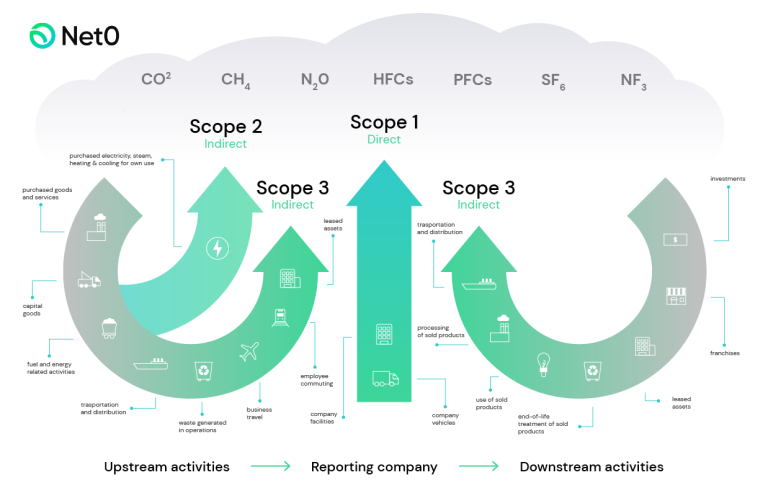With increasing global awareness of climate change, businesses face mounting expectations to manage their carbon footprint. Carbon accounting is a critical process for companies aiming to measure, report, and reduce their greenhouse gas (GHG) emissions. This guide provides a detailed approach to mastering carbon accounting, ensuring your business remains competitive and environmentally responsible.
What is Carbon Accounting?
Carbon accounting is the process of measuring, managing, and reporting a company’s greenhouse gas (GHG) emissions. It is a crucial step in understanding your business’s environmental impact and helps in setting realistic targets for carbon reduction. The essential elements of carbon accounting include:
- Identifying sources of emissions: Understanding where emissions are coming from within your business.
- Quantifying emissions: Calculating the amount of GHGs emitted.
- Reporting: Documenting and sharing the data with stakeholders and regulatory bodies.
- Reducing emissions: Implementing strategies to lower your carbon footprint.
Why is Carbon Accounting Important?
- Regulatory Compliance: Governments and international bodies are increasingly imposing regulations on carbon emissions. Accurate carbon accounting ensures compliance with these regulations, avoiding penalties and reputational damage. For instance, initiatives like the Task Force on Climate-related Financial Disclosures (TCFD) require companies to disclose their climate-related risks, making accurate carbon accounting essential.
- Financial Benefits: By identifying inefficiencies, businesses can reduce energy costs and improve operational efficiency, leading to significant cost savings. Companies actively managing their carbon footprint often identify areas to reduce energy consumption, such as optimizing HVAC systems or investing in energy-efficient equipment.
- Sustainability Goals: For companies committed to sustainability, carbon accounting is vital in tracking progress towards net-zero targets and other environmental objectives. Effective carbon accounting helps in setting and meeting ambitious sustainability goals. Many businesses use frameworks like the Greenhouse Gas (GHG) Protocol to standardize their carbon accounting practices and align with global sustainability initiatives.
- Stakeholder Trust: Transparent carbon accounting fosters credibility with customers, investors, and partners by demonstrating a genuine commitment to reducing environmental impact. This transparency can enhance your company’s reputation and appeal to environmentally conscious consumers, who increasingly prioritize sustainability in their purchasing decisions.
Steps to Implement Carbon Accounting
Establish a Carbon Accounting Team
Form a dedicated team responsible for carbon accounting. This team should include members from different departments to ensure comprehensive coverage of all emission sources. Having a cross-functional team helps in gathering data from various operations, ensuring that no emission source is overlooked.
Identify Emission Sources
- Scope 1: Direct emissions from owned or controlled sources (e.g., fuel combustion, company vehicles).
- Scope 2: Indirect emissions from the generation of purchased electricity, steam, heating, and cooling consumed by the business.
- Scope 3: All other indirect emissions that occur in the value chain (e.g., supply chain emissions, employee travel, waste disposal). Scope 3 emissions often represent the largest portion of a company’s carbon footprint and can be challenging to measure, but they are crucial for a comprehensive carbon accounting strategy.

Data Collection and Analysis
Gather data on energy usage, transportation, waste, and other relevant activities. Utilize tools and software designed for carbon accounting to streamline data collection and analysis. Accurate data collection is the foundation of reliable carbon accounting, and the use of digital tools can significantly enhance the efficiency and accuracy of this process.
Quantify Emissions
Convert collected data into CO2 equivalents (CO2e) using established conversion factors. Ensure accuracy and consistency in your calculations. Many businesses use the GHG Protocol’s calculation tools to ensure that their emissions data are comparable with those of other organizations and meet international standards.
Set Reduction Targets
Based on your emissions data, set realistic and achievable targets for reducing your carbon footprint. Consider short-term and long-term goals aligned with industry standards or initiatives like the Science Based Targets initiative (SBTi). Establishing science-based targets ensures that your reduction goals are in line with the global effort to limit temperature rise to 1.5°C.
Implement Reduction Strategies
Develop and execute strategies to achieve your reduction targets. This could include energy efficiency measures, switching to renewable energy, optimizing supply chains, and encouraging sustainable practices among employees. For example, businesses can invest in renewable energy sources like solar or wind power to reduce their reliance on fossil fuels.
Reporting and Communication
Regularly report your carbon accounting data to stakeholders, including regulatory bodies, customers, and investors. Transparency is key to building credibility and trust in your sustainability efforts. Public reporting can also enhance your company’s image and demonstrate leadership in sustainability.
Continuous Monitoring and Improvement
Carbon accounting is not a one-time activity. Continuously monitor your emissions and make necessary adjustments to your strategies. Regular audits and reviews will help identify new opportunities for reduction. Additionally, engaging in continuous improvement processes ensures that your company stays ahead of regulatory changes and market expectations.
Educate and Engage Employees
Ensure that your employees are aware of the company’s carbon accounting efforts and understand their role in reducing emissions. Training programs and internal communications can enhance engagement and promote a culture of sustainability. Employees who are informed and motivated can significantly contribute to achieving your carbon reduction targets.
Leverage Technology
Utilize advanced carbon accounting software and tools to automate data collection, analysis, and reporting. These technologies can improve accuracy and efficiency, making the carbon accounting process more manageable. With the right tools, businesses can gain real-time insights into their carbon footprint and make data-driven decisions to enhance sustainability.
Mastering carbon accounting is crucial for businesses that aim to thrive in an increasingly eco-conscious world. By understanding your carbon footprint, setting realistic reduction targets, and implementing effective strategies, your company can not only comply with regulations but also lead the way in sustainability. The journey to net zero starts with accurate carbon accounting, and now is the time to take action.
By incorporating the right tools, resources, and strategies, you can effectively manage your carbon emissions and contribute positively to the environment.
Ready to start your carbon accounting journey? Partner with Fuller Academy for expert guidance, tailored resources, and consultations to help your business lead the way in sustainability. Let’s work together to achieve your carbon reduction goals and secure a greener future.


